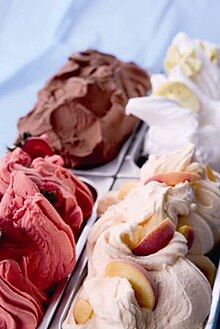Gelato (Italian: [dʒeˈlaːto]; lit. 'frozen') is the common word in Italian for all kinds of ice cream. In English, it specifically refers to a frozen dessert of Italian origin. Artisanal gelato in Italy generally contains 6–9% butterfat, which is lower than other styles of frozen dessert.[16][17] Gelato typically contains 35% air (substantially less than American-style ice cream) and more flavoring than other kinds of frozen desserts, giving it a density and richness that distinguishes it from other ice creams.[18][19][20]
 | |
| Type | Ice cream |
|---|---|
| Course | Dessert |
| Place of origin | Italy |
| Serving temperature | −14 to −11 °C 7 to 12 °F[1][2][3][4][5] |
| Main ingredients | |
| Ingredients generally used | Flavorings (fruit, nut, chocolate, etc.)[8][9] |
| Variations | Frozen custard |
| Other information | Usually served with a spade instead of ice cream scooper[15] |
Name
In Italian, gelato is the generic word for ice cream and means simply 'frozen', independent of the style, so every kind of ice cream is referred to as such.[21] In English, however, the term has come to be used to refer to a specific style of ice cream derived from the Italian artisanal tradition.[22]
History
In the 9th century, after the Muslim conquest of Sicily, frozen dessert like the sherbet was introduced in the island.[23]
In 1295, Marco Polo returned to Venice from China with a recipe similar to sorbet.[24]
Cosimo Ruggeri, Bernardo Buontalenti were 16th-century contemporaries who are credited by some sources with the invention of gelato,[25] while other sources claims that Sicilian cooks gradually modified over time the sherbet recipe giving birth to the earliest form of gelato.[23]
In Florence, Cosimo Ruggeri is credited with creating one of the first gelato, fior di latte, at the court of Catherine de' Medici, in a competition, with the theme "il piatto più singolare che si fosse mai visto" (lit. 'the most unique dish that had ever been seen').[26][27][28][29]
In the 1530s, Catherine de' Medici took gelato to Paris.[25][30]
Circa 1565, Bernardo Buontalenti, an innovator in ice conservation, made a sorbet with ice, salt, lemon, wine, milk, sugar, egg, and honey,[31] "plus orange and bergamot flavouring".[32] Buontalenti is credited with inventing gelato alla crema,[25][28] whipped cream or egg cream gelato,[31][33] the precursor to modern Florentine gelato.[34][28]
In 1686,[28] Francesco Procopio dei Coltelli, a Sicilian,[35] brought his grandfather Francesco's[36] gelato-making machine to Paris, opened Café Procope and introduced the dessert.[37] Procopio obtained French citizenship, and a royal license from Louis XIV, making him the sole producer of the frozen dessert in the kingdom.[38][39][40] Being one of the first to sell gelato directly to the public[41] (prior to then it was reserved only for nobles),[42] and making it known in the rest of Europe, Procopio is sometimes referred to as "The Father of Italian gelato".[43]
In 1843, in the United States, Nancy Johnson patented the hand-cranked ice cream freezer: this innovation led to the broader dissemination of ice cream and eventually to industrial production.[44] In 1904, in the United States, Emery Thompson built the first automated ice cream machine.[45]
In 1945, in Bologna, Bruto Carpigiani began selling gelato-making equipment,[46][47] and created Motogelatiera, the first automated gelato machine.[33] The batch freezer made it easier to store frozen desserts.[33] Carpigiani is a big manufacturer of gelato machinery.[47]
The largest ice cream cone in the world was created in 2011 in Rimini during the 32nd edition of the International Exhibition of Handcrafted Gelato, Pastry, and Bakery. The cone, made with over 2000 wafers, was 2.81 meters tall and weighed 70 kg. Leading the team of 7 artisans who accomplished the feat was the chocolatier Mirco Della Vecchia.[48]
Commercial production
The process consists of heating the ingredients to 85 °C (185 °F) for pasteurization. Then, it is lowered to 5 °C (41 °F) and mixed to the desired texture. The cold process mixes the ingredients and is batched in the freezer.[49] In the "sprint" process, milk or water is added to a package of ingredients which is then mixed and batched.[citation needed]
As with other ice creams, the sugar in gelato prevents it from freezing solid by binding to the water and interfering with the normal formation of ice crystals. This creates smaller ice crystals and results in the smooth texture of gelato.[50] Commercial gelati are often sweetened with inverted sugar, sucrose, dextrose, or xylitol,[51] and may include a stabilizer such as guar gum.[52]
Flavors
The original fior di latte ('milk flower') is a plain, base ice cream with no flavor and no eggs added. Stracciatella is fior di latte gelato with chocolate chunks. Traditional flavors of gelato include crema ('custard'), vanilla, chocolate, hazelnut, almond, and pistachio.[53] Modern flavors include a variety of fruit flavors and also new, unexpected flavors like extra virgin olive oil or basil.
See also
- Dairy
- Stracciatella – a gelato that includes chocolate chunks
- Semifreddo – a class of semi-frozen dessert
- Parfait – a type of dessert that is similar to a semifreddo
- Sherbet – a frozen dessert made from sugar-sweetened water, milk or cream, and various flavorings
- Custard – a dessert made with cream, eggs, and vanilla
- Frozen custard – a frozen dessert made with cream and eggs
- Frozen yogurt – a frozen dessert made with a base of yogurt rather than milk
- Non-dairy
- Granita – a semi-frozen dessert made from sugar, water, and various flavorings
- Italian ice – also known as "water ice", a frozen dessert made from syrup concentrate or fruit purees over crushed ice
- Sorbet – called sorbetto in Italian
References
Further reading
- Hartel, Richard W.; Goff, H.Douglas (2013). Ice Cream (7th ed.). New York: Springer. ISBN 978-1-4614-6095-4.
External links


